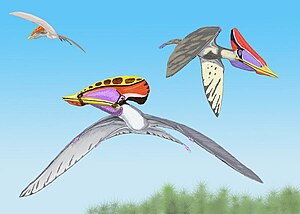Azhdarchoidea
| Azhdarchoidea | ||||||||||||
|---|---|---|---|---|---|---|---|---|---|---|---|---|

Tupuxuara leonardi and Tupuxuara longicristatus |
||||||||||||
| Temporal occurrence | ||||||||||||
| Barremium ( Lower Cretaceous ) to Maastrichtian ( Upper Cretaceous ) | ||||||||||||
| 130.7 to 66 million years | ||||||||||||
| Locations | ||||||||||||
|
||||||||||||
| Systematics | ||||||||||||
|
||||||||||||
| Scientific name | ||||||||||||
| Azhdarchoidea | ||||||||||||
| Nesov , 1984 |
The Azhdarchoidea were a group of medium-sized to very large short-tailed pterosaurs that were found worldwide in the Cretaceous Period . Together with Nyctosaurus, they survived as the only pterosaurs to the Cretaceous-Tertiary border and then became extinct. They also include Quetzalcoatlus and Hatzegopteryx , the largest known pterosaurs. The name of the Azhdarchoidea , which belongs to the pterodactyloidea, is the genus Azhdarcho , whose name goes back to the Persian name for dragon .
features
The Azhdarchoidea were, besides Pteranodon and Nyctosaurus , the only completely toothless pterosaurs. Their skull was built high above the orbit (eye sockets), in early forms it was often short like a parrot and provided with a large bone crest on the occiput, in the later Azhdarchidae it was rather long, with a marabous long beak and with no or only a small bone crest.
Fossils of the early Azhdarchoidea were found mainly in the Brazilian formations Santana and Crato as well as in the Chinese Jehol group . All three fossil sites were deposited in the Lower Cretaceous. These early Azhdarchoidea reached wing spans of a maximum of six meters. They probably lived above the sea and hunted their prey, perhaps in the manner of today's scissors ' beaks, by flying above the surface of the water, plowing through it with an open beak and, if it came into contact with a fish, closing the beak in one sudden movement. These early Azhdarchoidea disappeared on the border between the Lower and Upper Cretaceous.
The Azhdarchoidea from the Upper Cretaceous form a Monophylum , the family Azhdarchidae . With the exception of South America and Antarctica, fossils of the animals have been found worldwide. They were medium-sized to very large pterosaurs with long necks, strong hind legs and wingspans of up to twelve meters. Rather they inhabited terrestrial habitats, probably talked often on the ground and drove there to kind of giant storks or subsisted as marabouts of carrion . They became extinct at the end of the Cretaceous 65.5 million years ago.
Internal system
-
Azhdarchoidea
- Lonchodectidae
- Tapejaridae
- Neoazdarchia
Web links
swell
- David M. Unwin: The Pterosaurs. From deep time. PI Press, New York NY 2006, ISBN 0-13-146308-X .
